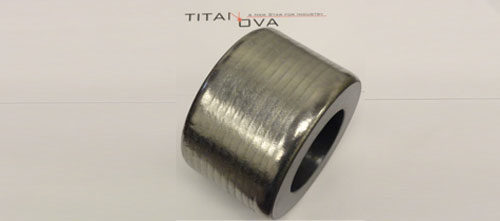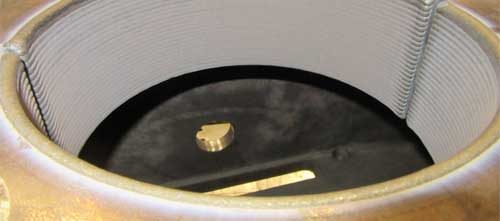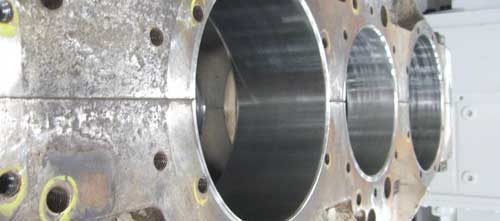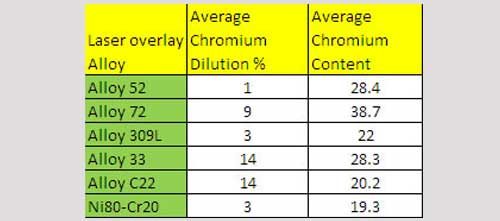Laser cladding uses laser energy as a heat source to melt and weld a material that has different and beneficial metallurgical properties onto a component with the lowest chemical dilution possible for a welding process. This allows one to cost effectively customize the surface properties of less expensive substrate to provide greater resistance to corrosion, oxidation, wear and high temperature fatigue strength. Why spend a fortune on making components out of special materials when you only need a specialized surface. Titanova’s direct diode laser cladding system has the ability to weld a very thin and smooth single pass layer of metal onto another metal substrate at high deposition rates, with little or no dilution.
Laser Cladding Glass Mold Component

Laser Cladding Glass Mold Component
Direct Diode cladding Cobalt

Direct Diode cladding Cobalt
Laser Cladding Cobalt

Laser Cladding Cobalt
Laser Cladding Capabilities
Titanova brings years of expertise in the area of diode laser cladding to the industry. This welding process makes use of customized diode lasers to create the thinnest and purest weld overlay achievable. No other welding process comes close to the quality that diode laser cladding offers.
This process permits the modification of the surface metal chemistry of functional parts without a significant amount of weld distortion or heat-affected zone. The surface modification benefits are for corrosion, erosion or both. For surface corrosion, Titanova, Inc.® offers laser cladding of corrosion resistant alloys such as all varieties of stainless steels (300 series and 400 series) and nickel and chrome based superalloys (Inconel™, Hastalloys™). For wear resistant protection, Titanova can laser clad a variety of Cobalt-6 alloys, iron chrome carbide and ceramic metal matrix materials (chrome carbide, tungsten carbide) in a self-fluxing Ni-Cr-Si-B metal matrix.
Advantages of Laser Cladding
Titanova offers the thinnest and flattest clads available in the overlay market place today. The resulting laser clad is very smooth and flat with very low dilution that requires minimal post machining. This unique capability translates into tremendous material and labor cost savings. There is no longer a need to put multiple layers down to achieve the specified surface chemistries. With Titanova’s laser cladding process; one pass will achieve the desired surface chemistries. With today’s volatile commodity metal prices, it makes more sense than ever to examine Titanova’s laser cladding services. Our deposition rates are independent of part size, Unlike typical arc processes, such as GTAW and TIG, which are limited due to drip-off associated with overheating, the laser process has a much lower heat input into the part. Titanova’s laser cladding is so versatile that we can clad everything from a tip of a nail to a large pressure vessel.
Applications
- Bearing surfaces
- Seal surfaces
- Pump components
- Drivetrain parts
- Turbine blades
- Extruders
- Mining bits
- Forging dies
- Rolls
- Tanks
Benefits
- Thin clads = less material costs = less distortion
- Minimal dilution
- Less pre and post machining requirements
- High deposition rates
- High quench rates = finer grain structure = higher corrosion potentials
- Production worthy process
- Highly controllable
- Part size independent = the smaller the better
Laser Cladding for Remanufacturing
Titanova’s diode laser cladding is a weld repair process that can be used to restore critical worn surfaces of metal parts. Typical critical surfaces are the bearing journals and seal surfaces for hydraulic shafts and valve seats. Laser cladding technology has less heat and dilution which leads to excessive distortion as compared to traditional arc welding, such as MIG and TIG over-lay processes. This is primarily due to the fact that traditional arc processes are limited to a minimum thickness and have excessive dilution.
<Learn about the difference between hardfacing and cladding.>
Unlike a thermal spray coating, a laser welded clad resists extreme shear stresses. Titanova has the ability to clad thin layers of exotic and harder materials (420, 431 SS, Stellites™) creating a better-than-new part. Titanova’s years of material expertise allows for the welding clad repair of a diverse set of base materials including cast iron, tool steel and stainless steel. Titanova’s advanced cladding process is a significantly faster and more cost effective method to remanufacture metal parts. Remanufacturing places the emphasis of wringing more productivity out of the OEM components.
Laser Cladding Reman Journal

Laser Cladding Reman Journal
Laser Cladding Main Shaft

Laser Cladding Main Shaft
Laser Cladding Seal Surface

Laser Cladding Seal Surface
Advantages of Cladding for Remanufacturing
The greatest benefit of direct diode laser cladding is the low heat input significantly reducing heat distortion. Other benefits include reduction of pre-machining and post-machining requirement due to the very small amount of dilution and heat effect zone. Unlike traditional overlay techniques the laser diode remanufacturing doesn’t create a hard zone in the immediate vicinity of the clad and base metal interface due to dilution. This traditional hard zone requires a much greater pre-machining depth such that the clad hardness is uniform for subsequent post machining.
Green Technology
With remanufacturing one can consider components that already have a significant amount of residual value in labor, energy, material, overhead and capital costs. Remanufacturing of commercial and military components can recoup 85% to 90% of the energy and materials in the components that are rebuilt, significantly reducing the demand for energy and
material resources required to sustain a population of components. This remanufacturing opportunity is even more compelling as metal and energy commodity prices continue to increase. Remanufacturing is an environmentally and financially green technology by lengthening the time that products stay out of the waste and recycling stream, thereby reducing pollution while saving money.
Applications
- Laser clad journals
- Remanufacturing journals
- Laser clad printing rolls
- Bearing surfaces of all kinds
- Crack shafts and cams
- Large variety of engine components
Benefits
- Reduces heat distortion
- Reduces the need for pre-machining
- Reduces the need for post-machining
- Uniform clad hardness for subsequent post-machining
Laser Cladding/Weld Overlay of Cast Iron
Titanova continues to develop new applications for the laser cladding process. Titanova has proven production worthy process for laser weld overlay repair of expensive ductile cast iron components. Titanova has developed material and process technology in order to achieve crack and pore free laser weld overlays for ductile cast iron using an equivalent of 316 SS.
This allows our customers to fix critical surfaces to re-man cast iron parts. Eliminating the need for expensive and unreliable Sleeving of bearing retainer surfaces
LASER REMAN CAST IRON BORE

LASER REMAN CAST IRON BORE
LASER REMAN CAST IRON

LASER REMAN CAST IRON
MACHINED LASER CLAD CAST IRON

MACHINED LASER CLAD CAST IRON
Laser Overlay Clad Tubing
More demanding emission standards have resulted in coal fired boiler fire box atmospheric chemistries that are extremely corrosive to conventional iron-based, low carbon tubing. This has forced the utilities and the boiler fabricators to clad the tubing with alloys that can with stand these corrosive atmospheres. Current cladding methods produce thick welded clad layers with high dilution, low quench rates, and rough surfaces. These thicker clad layers present a high thermal resistance due to the low thermal conductivity of the clad materials.
The resulting increase in temperature makes these thicker clads more susceptible to age related cracking and the rough surface leads to adhesion of slag with molten alkali sulfates that cause accelerated corrosion and further decrease heat transfer efficiency. For increased boiler efficiencies, future cladding must be a thin layer that does not degrade the boiler performance, does not reduce the clad material’s corrosion performance due to dilution, and must have low surface roughness to reduce slag adhesion. Simultaneously, the weld overlay technology has to be cost effective to reduce the fabrication, and sustainability costs.
Direct Diode Laser Clad Tubing
Laser cladding makes use of the laser as a heat source to melt and fuse (weld) onto the substrate of a component a material that has different and beneficial metallurgical properties. This allows one to cost effectively customize the surface properties of less expensive substrate to provide greater resistance to corrosion, oxidation, wear and high temperature fatigue strength. No other welding process comes close to the quality that diode laser cladding offers. This process permits the modification of the surface metal chemistry of functional parts without a significant amount of weld distortion or heat-affected zone. For the coal- fired boiler plants, surface modification benefits are for corrosion, erosion or both. For surface corrosion/erosion, the fire side of coal boiler laser cladding of corrosion resistant alloys such as all varieties of stainless steels (300 series), nickel and chrome based alloys (Inconel™, Hastalloys™). For wear or erosion resistant protection, diode lasers can clad a variety of cobalt alloys and ceramic metal matrix materials [Carbides – FeC, CrC, Tungsten Carbide (WC, T-Carbide) ].
Fireside Overlay Protection
Depending on the coal fired boiler, all surfaces may require some kind of fireside overlay protection. Potential candidates for laser diode cladding for corrosion and erosion protection include superheaters, reheater tubes and panels and lower and upper waterwalls. The areas that are of the most concern are the deoxygenated zone and the upper reaches of the boiler were soot erosion can be problematic.
These areas have shown that only a thin, chemical pure layer of clad material (Alloy C22, Inconel 72, Inconel 52) is required for long life. The problem is that standard GMAW or GTAW cladding processes cannot deliver thin and flat clads with low chemical dilution. This has led to age-related cracking and subsequent crevice corrosion. They are limited to a minimum of 0.80” or more. The diode laser allows the user to achieve the most efficient material process for those applications only requiring clads as thin a 0.030”.
Advantages of Laser weld Overlay Clad Tubing
Thin clads (0.030”) that have very low dilution and are thus chemically pure and functionally the same as the thicker clads produced by arc-based overlay deposition technologies. Thin clads reduce weld-induced distortions and the risk of age cracking. This cuts costs of nickel-chrome based cladding alloys. The diode laser cladding has high quench rates that result in very fine grain structure, which has enhanced high temperature creep, erosion and corrosion resistance.
LASER CLAD WATER WALL

LASER CLAD WATER WALL
AMEREN PIPE CLAD 6

AMEREN PIPE CLAD 6
DILUTIONS



